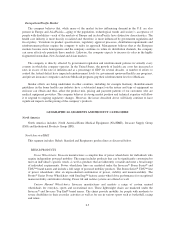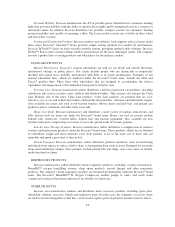Invacare 2007 Annual Report Download - page 19
Download and view the complete annual report
Please find page 19 of the 2007 Invacare annual report below. You can navigate through the pages in the report by either clicking on the pages listed below, or by using the keyword search tool below to find specific information within the annual report.subject to other general controls. In addition to general controls, certain Class II devices must comply with
product design and manufacturing controls established by the FDA. Domestic and foreign manufacturers of
medical devices distributed commercially in the U.S. are subject to periodic inspections by the FDA.
Furthermore, state, local and foreign governments have adopted regulations relating to the design, manufacture
and marketing of health care products. During the past two years, the company was inspected by the FDA at
eight domestic and foreign locations, with no adverse inspectional findings noted. In addition, the management
systems of all locations required to meet ISO 13485 requirements for Canada, Europe and other foreign markets
were inspected during 2007 and found to be certifiable.
From time to time, the company may undertake voluntary recalls or field corrective actions of our products
to maintain ongoing customer relationships and to enhance its reputation for adhering to high standards of quality
and safety. None of the company’s actions has been classified by the FDA as high risk (Class I). The company
continues to strengthen its programs to better ensure compliance with applicable regulations, particularly those
which could have a material adverse effect on the company.
The company occasionally sponsors clinical studies, usually involving its respiratory or sleep products.
These studies have historically been non-significant risk studies with human subjects. Effective December 27,
2007, such studies, their protocols, participant criteria and all results, must be registered in the Clinical Registry
managed by the National Institutes of Health and available to the public via the Internet, according to a new law
that was part of the FDA Amendments Act signed September 27, 2007 (Public Law 110-85).
Although there are a number of reimbursement related issues in most of the countries in which Invacare
competes, the issues of primary importance are currently in the United States. There are two critical issues for
Invacare: eligibility for reimbursement for power wheelchairs for elderly patients and the provisions of the 2003
legislation related to prescription drug coverage under Medicare. With regard to power wheelchairs, the Centers
for Medicare and Medicaid Services, or “CMS,” implemented in late 2006 a series of changes to the eligibility,
documentation, codes and payment rules that has impacted the predictability and access to this benefit. Invacare
and the home care industry are working hard to convince the CMS and the Bush administration to make
pragmatic changes that are consistent with industry practices, to afford seniors appropriate access to their home
medical equipment. With regard to the 2003 legislation, CMS is now implementing a “competitive acquisition”
program in ten large metropolitan areas, beginning July 1, 2008. An additional 70 metropolitan areas also will
participate in this program, beginning sometime in 2009. See “Management’s Discussion and Analysis of
Financial Condition and Results of Operations.”
In 2009, the competitive bidding program will be extended to 70 of the largest metropolitan regions. In early
2006, Congress passed the Deficit Reduction Act which includes payment cuts to home oxygen that will take
effect in January 2009.
Although none of these changes are beneficial to the home care industry, the company believes that it can
still grow and thrive in this environment. The home care industry has not received any cost-of-living adjustments
over the last few years and will try to respond with improved productivity to address the lack of support from
Congress. In addition, the company’s new products (for example, the HomeFill™ low-cost oxygen delivery
system), can help address the cuts the home care provider has to endure. Moreover, effective January 1, 2007,
Medicare provided for increased payment for this new technology which further enhances the cost advantages
this technology offers. The company will continue to focus on developing products that help the provider
improve profitability. Additionally, the company plans to accelerate our activities in China to make sure that the
company is one of the lowest cost manufacturers and distributors to the home care provider.
I-14
























